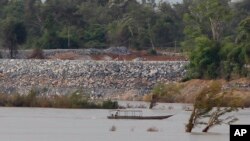As the construction of hydropower dams in China booms, both China and Laos are looking to sell off excess energy to their Southeast Asian neighbors, with experts saying cheaper electricity costs can help boost development in countries like Cambodia.
Brian Eyler, director of the Southeast Asia program at the Stimson Center, said an abundance of cheap power from China could stall Laos’ plans to become the “battery of Southeast Asia.”
“In the big picture, the amount of power that can come out of Laos’ hydropower development is a tiny fraction of the actual demand that countries like Thailand, Laos, Cambodia, and Vietnam need,” he said.
Power from China’s Yunnan province, which has seen numerous hydropower developments in recent years tap into the upper reaches of the Mekong and its tributaries, will cost as little as three cents per kilowatt hour, he added, meaning the cost when it reaches Cambodia will still be cheaper than buying power from Laos’ own mega-dams, the Xayabury and Don Sahong.
“Because the government likes to take a centralized hub and spoke approach, you have big load centers in urban areas, but the generation capacity is always in the periphery, in the mountains, so if you think about hydropower and the idea is just to build out transmission and distribution systems to those far afield assets and link them up to the urban center,” Eyler said.
“But the world isn’t moving that way. The world is moving toward a decentralized system where power is flowing in multiple directions all around you. So urban areas can produce electricity as well as a solar distributive generation, wind farms close to urban areas. There is really no need to continue on with that purely centralized system approach.”
He added that the cheap electricity provision from Yunnan provided the governments of Southeast Asia with a window of opportunity to switch to renewable energy, particularly solar, wind and biomass energy, which could provide a long-term solution to energy shortages.
Some 30 hydropower dams are being constructed in Laos and about seven in Cambodia, funded predominantly by Chinese state companies.
Courtney Weatherby, a research analyst with the Stimson Center, said Cambodia had a choice now to invest in solar power.
“I think it’s very possible and there is the technical expertise available and the international community to help find an alternative pathway that would meet all of the needs for Laos, Cambodia, and Vietnam for revenue, for electricity and to better protect the social, environmental situation that is currently existing around the rich Mekong river, and it does need to have discussions started now on this topic instead of following business as usual,” she said.
The price of technology needed to build solar panels has declined dramatically in recent years, making it more profitable in the long term to invest in solar power, experts say.
But many countries are resistant to change and view solar investments as too risky for too little reward.
Meanwhile, the construction of dozens of mega dams along the Mekong River system has come under fire for their social and environmental impact.
“The biggest challenge at this point and time is that we are starting to see these impacts,” said Weatherby. “The biggest challenge moving forward is to ensure that any future projects are done in a way that coordinates with others so you can mitigate and lessen the impacts as much as possible because some of these developments are just going to happen but it could be done in a haphazard way where projects individually look at the mitigation and have no coordination and so the end result could be a disaster for countries downstream.”
In a summit last week, China pushed through a five-year development plan for the Mekong River in a meeting with downstream nations. Li Keqiang, the Chinese Prime Minister, said after the meeting that cooperation between the countries was “not merely paying lip service.”
“We talked about important principles in the meeting. We have to respect each other and consider each other with equality for common development,” he said.
The actual submitted plan is so broad - covering almost every area of governance - that it is hard to point to a specific objective and no concrete steps appear to have been taken to address the growing number of man-made threats to the river system.








